"Standard" battleships of the USA, Germany and England. British "Rivengi"
Of course, at the stage of determining the performance characteristics of the Rivenji looked like a step backwards in comparison with the magnificent Queen Elizabeth, built according to the program of the previous year. The main differences from the "Queen" were to be:
1. Slower speed: instead of 25 knots. total 21,5 (and then 21) nodes.
2. Return to a mixed power plant — instead of purely oil-fired boilers, units should be installed on the Rivengi that can operate on both oil and coal.
3. And finally, the cost - the UK wanted a few cheaper battleships than the high-speed Queen Elizabeth.
True, about the last point there are a lot of discrepancies. So, A.A. Mikhailov, in his monograph “Royal Soverin type ships of the line”, indicates that in the case of the Rivends, the British wanted to stay within 2 million 150 thousand f.st., while the cost of Queen Elizabeth was from 2 million 408 thousand f.st. to 3 million 14 thousand f.st. All anything, but then AA Mikhailov indicates the cost of "Rivendjee" from 2 406 500 f.st. (lead ship) to 3 295 800 f.st. (built later than all "Remillis") O. Parks, in his famous multi-volume work devoted to the battleships of England, indicates the cost of battleships of the type "Queen Elizabeth" at the level of 1 960 thousand f. Art., but the price of "Rivengi" does not say anything.
The author of this article could not find out the exact reason for this discrepancy. Of course, it can be assumed that the whole thing is about inflation: World War I hit hard enough on almost all the currencies of the world, and the British pound sterling was no exception. “Queen Elizabeth” type battleships were already under construction during the war years, and perhaps the price is from 2,4 to more than 3 million f.st. represent the actual costs of their construction, and the 1 980 th. - the value given to the pre-war rate of the pound sterling. But in this case, the Admiralty could not evaluate the "Rivenji" in 2 150 thousand f.st. even before the war — how did they know then about the beginning of the war and the inflation that arose in connection with it? On the other hand, it cannot be assumed that the cost of the ships indicated by O. Parks does not include any nuances of their configuration either - what kind of equipment is this, in 50% of the cost of the ship itself?
In any case, we can speak about one thing with certainty - the Rivendis should have been cheaper than their predecessors.
Artillery
The main caliber was repeated on the Queen Elizabeth type battleships — four two-gun turrets of 381-mm Mk I guns. Recall that these artillery systems had a barrel length in 42 caliber and sent projectiles with an initial speed of 871 m / s. The maximum elevation angle also corresponded to the Queen Elizabeth settings - 752 degrees, which ensured the maximum range of 20 cables. The placement of the towers also fully corresponded to that adopted on the battleships of the previous series - they were located linearly and sublimely, two in the extremities, with the artillery grounds of each pair of towers located under the towers and between them. Ammunition was 121 shots on the gun.
Mine caliber was introduced 14 152-mm guns MK-XII, which is less on the 2 guns than the "Queen Elizabeth." Initially, the "Rivendzhi" supposed to put the same 16 guns, of which a dozen were located in the dungeon, and four guns were to stand openly on the upper deck, protected only by shields. Subsequently, it was decided to abandon the aft pair of “open” cannons, and the bow ones located in the area of the chimney were placed in a superstructure, defended by a “polukademeat” - but this happened after the ships entered service during one of their upgrades.
In general, despite the reduction in the number of weapons of mine caliber and a decrease in their protection (only 12 cannons were in the casemates), the Rivendzha MSS should be considered the best in comparison with all previous British battleships. The fact is that, taking into account the high filling of the casemates on battleships like the Iron Duke, the British shifted the casemate to the stern. As a result, although the RNVJ's 152-mm artillery was located at about the same height as the rest of the British battleships, it was still overwhelmingly less. Ammunition repeated the "Queen Elizabeth" - 130 shots at the gun, plus 100 lighting shells on the ship.
In addition to the above, at the time of entry into service, the Rivenji had two 76,2-mm anti-aircraft guns and four three-pound salute guns, as well as five Maxim machine guns. Not without cost, of course, without mine weapons - it was represented by four submarine 533-mm torpedo tubes with 5 ammunition torpedoes on the unit.
Reservation
The scheme of armor protection of battleships of the “Rivend” type in many respects repeated that used on the “Queen Elizabeth”, but still had significant differences from it.
The basis of the vertical defense was 330 mm of armor belt, stretching from the middle of the barbet of the 1-th tower to the middle of the barbet of 4-th. On Queen Elizabeth, the height of the armor plates was 4,4 m, but the 330 mm section only lasted for 2,28 m. Above it on 1,21 m, the armor plate had only 152 mm thickness, and below (0,914 m) it was 203 mm. But on the "Rivendzhe" height of armor plates was less on 52 - only 3,88 m, but then they were 330 mm thick along the whole height. Without a doubt, such protection was significantly superior to the one that the queen-type Elizabeth type battleships had.
From 330 mm, armored belt into the bow and stern continued with 152 mm plates of the same thickness, which, closer to the extremities, decreased to 102 mm. The 102 belt in the nose should be booked with a thickness of one inch (25,4 mm), although it is possible that this was not armor, but just a covering of increased thickness, the feed remained unprotected. At the same time, 102 mm sections were closed by traverses of the same thickness, only in the stern it was located perpendicular to the axis of the ship, and in the bow - at an angle of about 45 degrees. to her. This, of course, was not the only traversing - in places where 152 mm and 102 mm of armor were closed, 38 mm of armor reassembly were located in the bow and stern, and the edges of 330 mm of armor plates and the front walls of barbets of 1 and 4 of the main caliber 152 mm traverse beams were connected at an angle to the longitudinal plane of the ship. That is, in order to get into the supply pipe of the bow or stern turret, the enemy shell first had to pierce 152 mm onboard armor and then 152 mm traverse, located at a large angle to the projectile flight path.
We described the main armored belt of the ship - above it was the second, upper armor belt, which had a thickness of 152 mm. It was shorter than the 330 mm section of the main armor belt: starting from the same location as the 330 mm armor plate in the nose, that is, around the middle of the barbet of the nasal (1) tower, it lasted only until the middle of the barbat of the 3 tower, leaving the fourth completely unprotected. At the same time, from the edges of the upper, 152 mm of armor belt, there were also “slanting” traverses covering the barbety of 1 and 3 to her towers.
And, finally, a casemate was located above the upper armor belt, which was even shorter than the upper armor belt. Its thickness at the side was 152 mm, while from the stern it was locked with 102 mm by means of a beam that runs perpendicular to the axis of the ship in the aft fighting cabin, and in the nose of the 152 mm armor plate of the casemate, again at an angle to the ship’s diametral plane, connected to 2- oh tower, adjacent to it at about the middle of its length. The casemate itself was divided along the axis of the ship 51 mm by armored partitioning, and the tools in it were divided by the armored 38 mm, which did not reach the center of the hull, however.
“Rivendzhi” also had anti-torpedo bulkheads that went along the sides along the 152-330 mm sections of the main armor belt, that is, from the nasal beam of the 38 mm to the aft one of the same thickness. The height of the anti-torpedo bulkhead ran from the bottom of the ship to the middle deck, that is, even slightly above the waterline. Where this bulkhead was located behind the 152-330 mm armor belt, its thickness was 25,4 mm, below - 38 mm. In addition, the vertical armor had chimneys - mm 25 from the main armored deck and to the roof of the casemates, above, to the base of the chimney - 38 mm.
As for the horizontal protection of battleships of the “Rivend” type, the ships of this type had 5 decks: the forecastle deck, upper, main, middle and lower, and they all had some kind of reservation on this or that section, so it’s all to be described not so easy. The location of the decks is indicated on the above ship's armor protection scheme, and we will describe its horizontal protection, moving from top to bottom.
According to some data, the forecastle deck was not booked anywhere, except for the section on which it was also the roof of the casemate of 152-mm guns, and there it consisted of 25,4 mm of armored plates. It turns out that the specified protection "Rivengi" received for the duration of the 2-th tower of the main caliber and to the aft log house. However, according to other sources, the forecastle deck had protection outside the dungeon - in the bow, up to the 1 tower of the main caliber 19 mm, aft, to the barbet of the third tower, 25 mm (this is shown in the diagram from O. Parks book)
Below was the upper deck - it was the "floor" of the casemate and lay above the upper 152 mm belt, continuing, of course, and further, to the bow and stern of the ship. But it was armored only on the area limited by the 152 mm belt and traverses, that is, from the 1-th to the 4-th tower of the main caliber inclusive. Its thickness was variable, ranging from 25,4 to 31,7- 38 mm, unfortunately, it was not possible to figure out exactly where the booking differentiated.
Well, then we turn to the base of the horizontal armor protection "Rivenja" - the main armored deck. Its horizontal part was held at the level of the upper deck (at the level of the upper edge of the 152-330 mm armor belt) throughout its length, and had a thickness of 50,8 mm above the ammunition cellars and machine rooms, but the boiler rooms, apparently, were only protected 25,4 mm armor. The horizontal section of the armor deck was connected to the lower edge of the main armor belt by bevels that had a thickness of 50,8 mm throughout the citadel. Thus, the ship was booked throughout the 152-330 mm armored belt, from the bow 38 mm traverse to the stern. But behind them in the stern and bow to the 102 mm, the main deck did not have traverses and was reserved from side to side of the 25,4 mm. Further from the 102 mm, the traverse to the stem and the sterner the upper deck of the Rivendzha was not booked.
The middle deck was booked in the stern, above the cellars of the 4 tower and stern torpedo tubes (25,4 mm), between 38 mm and 102 mm traverse - 50,8 mm, for 102 mm traverse to the stern stem (above the steering) 76-XNXXXXXXXXXXXXXXXXXXXXXXXXXXXXXXXXXXXXXXxxxxxxxx The bottom one - on the contrary, only in the nose, from the barbet of the 102 tower and almost to the stem - 1 mm.
In general, the following was obtained. Above the boiler compartments, the total horizontal protection reached 82,5 mm (25,4 mm deck forecastle, upper deck 32 mm and main 25,4 mm). The strongest horizontal protection was above the cellars - basically the same 82,5 mm (31,7 mm upper deck and 50,8 mm main), but in the stern tower 107,9 mm (also 25,4 mm middle deck), and the same protection had engine rooms for about half of its length, only there, instead of the middle deck, additional protection was created by the “roof” of the casemate - 25,4 mm deck of the forecastle. Above the steering devices, the protection was 76-102 mm.
I must say that such protection had, on the one hand, a lot in common with the previous British "capital" ships, but on the other - it was very different from them. The common point was the “patchwork” pattern, when seemingly acceptable thicknesses were spread over several decks. The difference was in the unusually high position of the main armored deck - if earlier its horizontal part barely towered above the waterline, then in battleships of the Rivend type it ran at the level of the main deck, that is, at the level of the upper edge of the main armor belt, 2,44 m above the level of the constructive waterline.
Such an innovation can hardly be called a great success of British designers, and the thing was this. We have already discussed the vulnerable place of Queen Elizabeth type battleships, which was a consequence of the differentiated thickness of its main armor belt: the problem was that the enemy shell, breaking through the armor plate where its thickness was 152 mm, “flew” into the armor deck of some 25,4 mm thick.
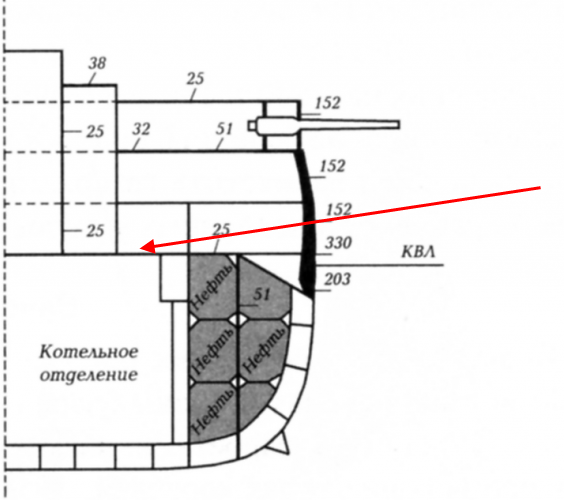
Such protection could not repel any fragments of a large-caliber projectile, nor, all the more, the projectile itself - but the latter had good chances to break through the 152 mm belt and 25,4 mm deck and enter the engine or boiler room as a whole - or explode during the breach of the armor deck.
So, on the "Rivendzha" designers have the opportunity to largely get rid of this shortcoming, due to the fact that its main armor has 330 mm across the entire height of the armored plate. If the armored deck were kept at a height like that of Queen Elizabeth, in order to get to the 25,4-50,8 mm of the deck, the projectile needed to overcome 330 mm of armor, not 152 mm. Of course, the projectile could get into the upper armor belt, which had only 152 mm, but the fact is that in the case described by us it would be positioned high enough above the main armored deck, and the projectile would directly hit it. Of course, the projectile, breaking through the upper armor belt, could simply explode inside the ship, and in this case, the 25,4-50,8 mm horizontal armor plates did not have many chances to reflect its fragments, but even in this case only fragments would pass into the protected premises - significantly lost their kinetic energy. So the scale of the damage inflicted by them would still be incomparable with the situation when a heavy projectile exploded directly on the deck, or even passed it in general.
However, the designers of "Rivendzha" did not leave the armored deck at a height typical of the "Queen Elizabeth" - they raised it above the waterline to the level of the upper deck. The result was the following: at the level of the main armor belt, the protection of the Rivenja, which included 330 mm of armor and 50,8 mm of the armored deck, significantly exceeded that of the Queen Elizabeth, which had an 203-330-152 of variable thickness armor (bottom-up) and 25,4 mm bevel and deck behind the slab. However, above the 330 mm belts, battleships of the Rivend type received the same “window” in the defense that their predecessors had - the enemy shell, breaking the 152 mm upper armor belt, could easily cater to the horizontal part of the armor deck 25,4-50,8 mm thick.
In other words, instead of destroying the vulnerability of “Queen Elizabeth” type battleships, the designers of the Rivengers simply put it one floor (one deck) higher. As for the protection of other important elements of the structure, their booking differed little from what battleships like the Queen Elizabeth had.
The 381 mm towers had a 330 mm forehead, the side plates 280 mm and a roof 114 mm. (The Queen Elizabeth towers may have only had 229 mm side armored plates and most certainly a roof 108 mm thick). The barbets of the towers were an extremely difficult articulated structure that had protection from 102 to 254 mm. For example, the barbet 4, the stern tower above the upper deck, and in the gap between the upper and main deck, where the armor was completely absent, had 254 mm armor on the sides, 229 mm in the stern direction and 178 mm on the back side, facing the 3 tower. Below, between the main and middle decks, where there was a 152 mm armor belt, the barbet thickness was 152 mm from the sides and aft, but 102 mm in the part facing the 3 tower. In general, it can be stated both the desire of the British in every possible way to reduce the mass of barbets, and the fact that they have gone too far on this path - even 254 mm barbet looks like a frankly weak defense.
The conning tower had a 280 mm wall and an 152 mm shaft, going down to the central post. The aft conning tower (torpedo shooting control post) had, respectively, 152 and 102 mm.
Power plant and PTZ
Strictly speaking, before proceeding to the description of machines and boilers of battleships of the “Rivend” type, we should talk about their anti-torpedo protection, but if we do this, some of the PTZ nuances will not be clear, so we will tell about it in this section .
History Rivenjay’s power plant is akin to a good detective. Initially, the British wanted to get a ship capable of achieving 21,5-knot speed on the afterburner - calculations showed that in a normal displacement of 25 tons (this is how the future battleship was seen by the British) a power plant with a capacity of 500 hp would be enough for this. At the same time, it was decided to abandon purely oil heating using boilers capable of working both on oil and on coal. This decision, on the one hand, looks like a shaped retrograde, but on the other, it had very good reasons. Firstly, it seemed that such boilers were cheaper, secondly, coal pits were then considered an important element of the ship’s protection, thirdly, the Rivenjams still had to operate in line with the coal coal battleships of the previous series, where the advantage was clear -oil ships could not be realized. There was also an important “fourth”: there was no oil in England itself, so any interruptions in its supplies would have most negatively affected the combat readiness fleet - to make it completely dependent on imports seemed rash. Oddly enough, this was a very significant consideration - despite the fact that during the First World War the Hochzeflotte was unable to challenge the Royal Navy's dominance, in 1917 there was a lack of oil in the metropolis.
Thus, it was decided to install boilers for mixed heating, and as far as power machines, it remained unchanged, even when the displacement of the future Rivendz “crawled” up during the design — the admirals preferred to reduce the maximum speed by half a node, there is up to 21 ties, leaving the power plant in its original form.
However, then John Fisher returned to the Admiralty, and all the above plans flew to Tartar. In January, 1915, Mr. D. Fisher, insisted on purely oil heating boilers, as it turned out, small changes were enough to increase the capacity of the power plant to 40 000 HP. At the same time, the speed of the future Rivendzhy was supposed to increase to 23 nodes. That is how they were built in the end.
However, the "23-node" battleships "Rivengi" never became. Their displacement rapidly grew - starting from 25 500 t, it very quickly turned into 25 800 t, and then imperceptibly turned into 27 970 - 28 000 t. However, taking into account the increase in machine power, this was not critical, because speed in 21, the node to which the admirals agreed, remained perfectly attainable. But there was another problem.
The fact is that, as we have said, coal pits, in addition to fuel storage, were also part of the constructive protection of the ship, which it has now lost. According to the project, the Rivendjee width was smaller than that of the Queen Elizabeth battleships, while the British believed that the coal holes allowed to reduce the thickness of the anti-torpedo bulkhead — it was only 25,4-38 mm against 50,8 mm by Queen Elizabeth and it was obvious that in terms of anti-torpedo protection "Rivendi" will be inferior to their predecessors. This, of course, was deemed unacceptable.
Of course, one could simply increase the thickness of the anti-torpedo bulkhead, but the British went the other way. They had been experimenting for some time with the “Chatam raft”, which was a compartment of a warship in mid-section, intended for field tests of the impact of underwater explosions on the hull. These experiments convinced them of the usefulness of the boules.
I must say that from the entire series of battleships of the type “R”, only one Remillis received boules during the construction process - the remaining four ships were decided to equip them with 1917 in October, after they were commissioned. Unfortunately, we have to admit that there is very little information on bulls, and the information that exists is very contradictory.
The location of the boules is clearly visible in the diagram below, but it should be noted that the Royal Oak is depicted on it as of 1937.
A.A. Mikhailov writes that the boules added 2,13 m to the width of the battleship, but it is not clear from the context, both or each: but apparently, it is still the width of one boule. Also, the respected author reports that the mass of the bulls was 2 500 tons, but this is extremely doubtful, because he himself claims in applications that the normal displacement of the Royal Sovereign left 27 970 tons after commissioning, and after installing the bulls - 29 560 T. For “Rivendzha” 28 000 and 29 560 T are indicated, respectively, that is, the weight of the bulls on these ships was no more than 1 590 T. True, for the “Remillis” the normal displacement is indicated by a much larger 30 300 T. a lot of 2 300 tons or a little more. We can only assume that the design of the boules that were installed on the "Remillis" and the other ships of the series, differed. Although another option is possible - in order to ensure the ship’s unsinkability, the British completed the boules with steel pipes with sealed ends, it was assumed that this would reduce the shrapnel damage and give the ship additional buoyancy. The mass of these pipes on one battleship was 773 t. If we assume that the rest of the ships of the series received boules without these pipes (which were an extremely dubious innovation), then reducing the mass of the bulls to 1 590 t looks logical, but this is nothing more than a hunch. But in general, it should be recognized that the installation of the bulls on the Rivendzhi provided them with the best protection against underwater explosions among all the British battleships.
But back to the power plant. As we said earlier, the transition to oil heating, coupled with some improvements in turbines, led to a sharp increase in power plant capacity. Unfortunately, to say exactly how this increase affected the speed of the ships, there is no possibility. The problem is that all the battleships of the Rivend type were incorporated into the Royal Navy during the war years, and their sea trials were carried out according to an abbreviated program, and not in the same way as was customary before the war.
In fact, we have only data about the tests of the battleships “Rivend” and “Ramilles”, and the first one at the time of their conduct did not have bulls. However, both battleships on tests had not normal, but full, or close to this displacement, and showed:
"Rivendzh" (without boule) - reached the speed of 21,9 knots. at the power of 42 650 hp, the displacement at the same time was 30 750 t.
Remillis (with bullets) - 21,5 knots. with power 42 383 hp and a displacement of 33 000 t.
Calculation by the formula, using the admiralty coefficient, suggests that these ships in their normal displacement could count on 22,4 and 21,9 knots. accordingly, the installation of the bulls “ate” no more than half a node, and this is very similar to the truth. But in any case, even without taking into account the bulls, and despite the fact that all of the battleships of the Rivend type, the power of the power plant on tests exceeded the planned 40 000 hp, they did not reach the planned 23 nodes.
And, again, it should be understood that all of the above speeds are achieved when forcing turbines. Without it, the speed of the Rivenger was, apparently, on the 1-1,5 node less than the maximum. It is not quite clear where O.Parks took the data that in normal displacement and without forcing mechanisms of this type of battleships developed no more than 19,7-20,4 knots, but these figures are certainly similar to the truth. And it is clear that after several years of operation, they have decreased.
Therefore, we can say that the decision of D.Fisher to transfer “Rivengi” to oil heating, and increase the power from 31 000 to 40 000 hp it was fully justified - one could say it saved the battleships of this type. With the old power plant, the British could no longer increase the displacement of the ship from the originally planned, so that the battleships turned out to be much less perfect than in reality, and the speed would still be at the level of the minimum acceptable values. Installing the same bulls would most likely be unacceptable.
The fuel supply of battleships of the type “Rivend” was 3 400 tons of oil and 160 tons of coal, the course of the course, unfortunately, is unknown.
In general, the following can be said about battleships of the type “Rivendj”. In fact, even before the creation of the 15-inch (381-mm) guns, the British began to build high-speed battleships carrying such guns - at that time they were the most powerful artillery systems in the world. In the future, the British headed for the creation of a fleet of "15-inch" battleships, which is very well seen by their pre-war programs. Thus, under the 1912 program, 5 ships of the Queen Elizabeth type were laid - their construction marked a change in the views of the British, who did not consider that the British battlecruisers could successfully fulfill the role of the “high-speed wing” in a linear battle. Now the Admiralty believed that this role would be able to fulfill "25-nodal" battleships, whose speed, although not in line with the battle cruiser, but far exceeds the standard "21-nodal" ships of the line. However, this did not mean that the British were going to abandon the “21-nodal” battleships, and according to the 1913 r program, the five “21-nodal” dreadnoughts of the Rivend type got onto the stocks.
The program of the next year, 1914, envisaged the creation of another battleship of the Queen Elizabeth type and three types of the Rivend type, and after its completion the Royal Navy would have 8 “standard” and 6 high-speed battleships armed with 15-inch guns, and it is possible that the construction of "15-inch" battleships, even if on the adjusted projects, would continue in the 1915 year. However, the First World War intervened in the construction programs of the fleet, and the new construction of the battleships was suspended and resumed in the post-war years - of course, on completely different projects.
We will not give now a detailed analysis of the project of battleships of the “Rivend” type, we only note that it was originally created as a “budget” battleship, from which one can hardly expect much - and yet these ships claimed to be one of the strongest battleships of the world. The main trump card of the Rivendjee was 381-mm heavy-duty guns at that time, which were supposed to give them an advantage over foreign peers of the same class. When designing ships of the Rivend type, the British made great efforts to strengthen their defense in relation to the ships of previous projects. Nevertheless, the result of their efforts can hardly be called ideal, since along with successful solutions, such as the boules, the British made a number of miscalculations in the Rivenja reservation scheme. As a result, at the time of their creation, the battleships of the “Rivend” type became the most heavily protected British battleships, but, without any doubt, by changing the booking scheme, more could be achieved.
To be continued ...
PS The fate of the ships is unusually bizarre: the Royal Soverin battleship, one of the R-series ships, served for almost five years under the Soviet flag, thus becoming the strongest battleship of the Russian Empire and USSR.
- Andrei from Chelyabinsk
- "Standard" battleships of the USA, Germany and England. Who is better? Introduction
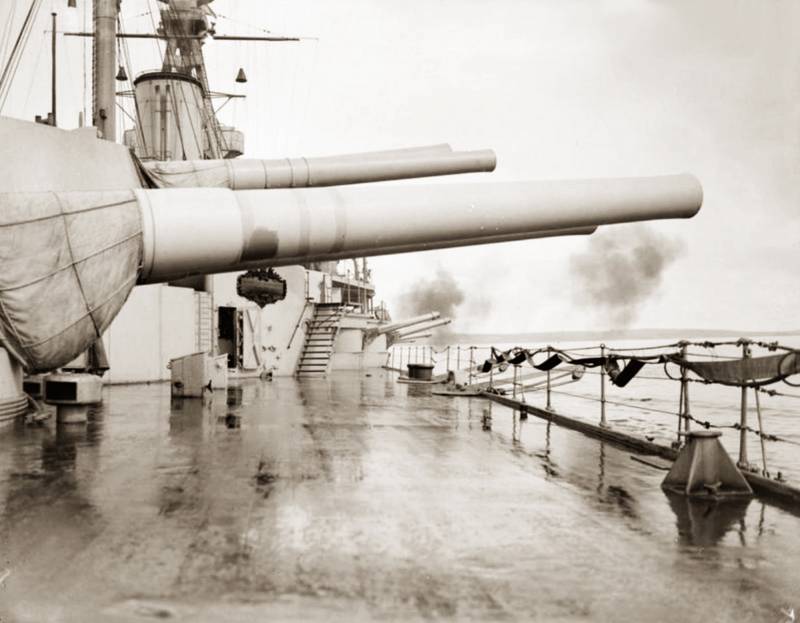
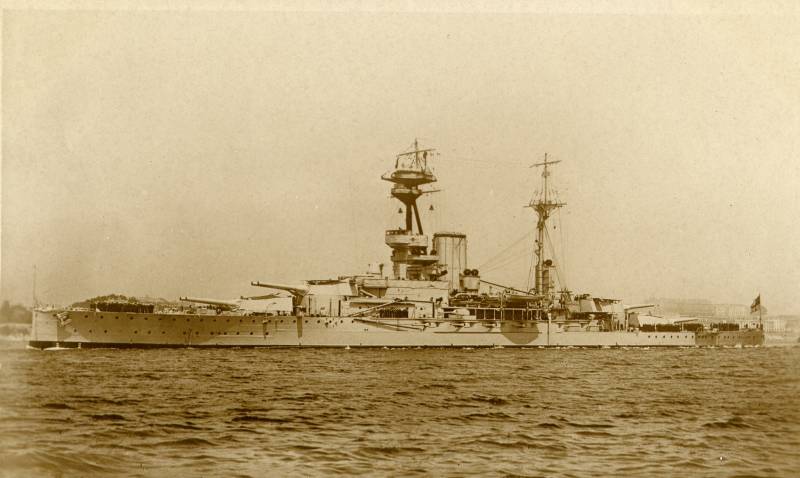
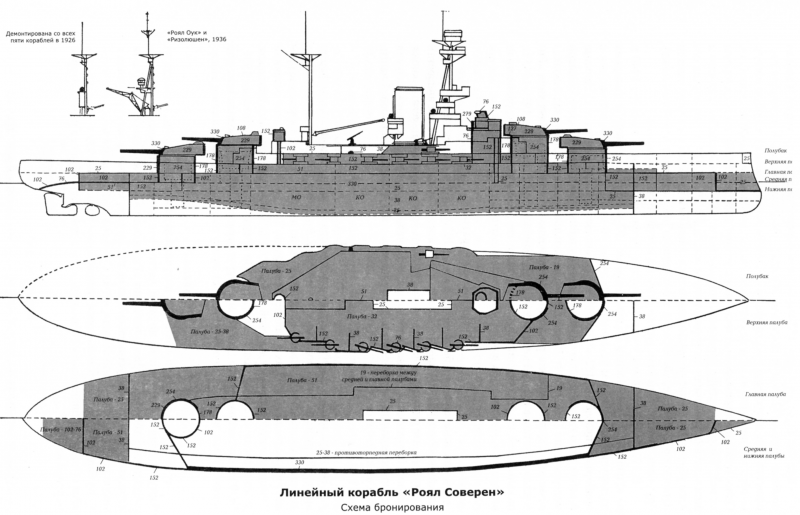
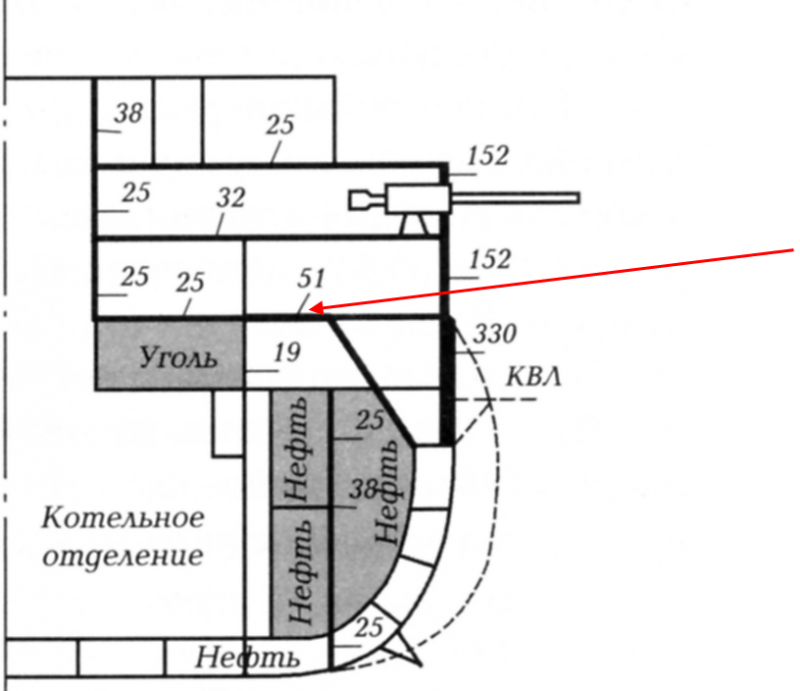
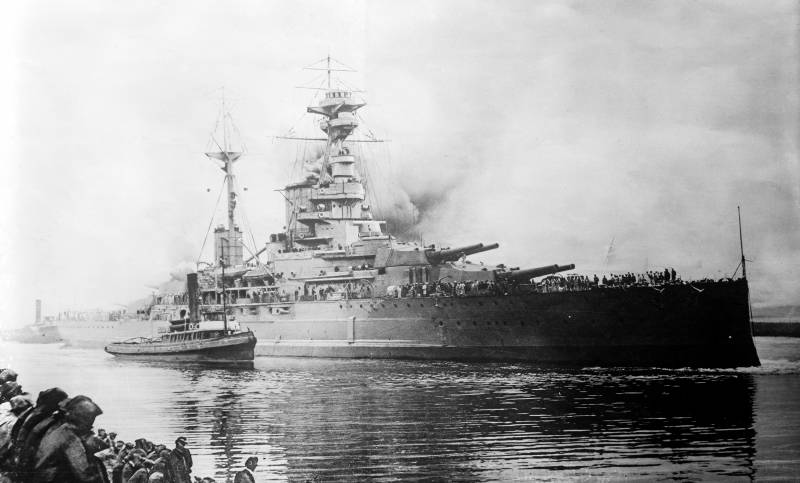
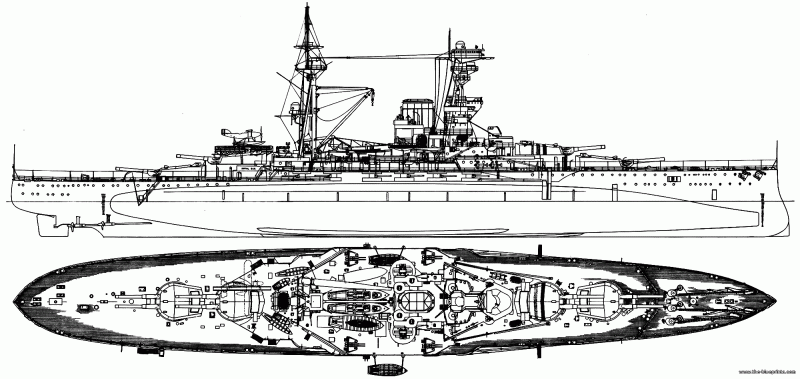
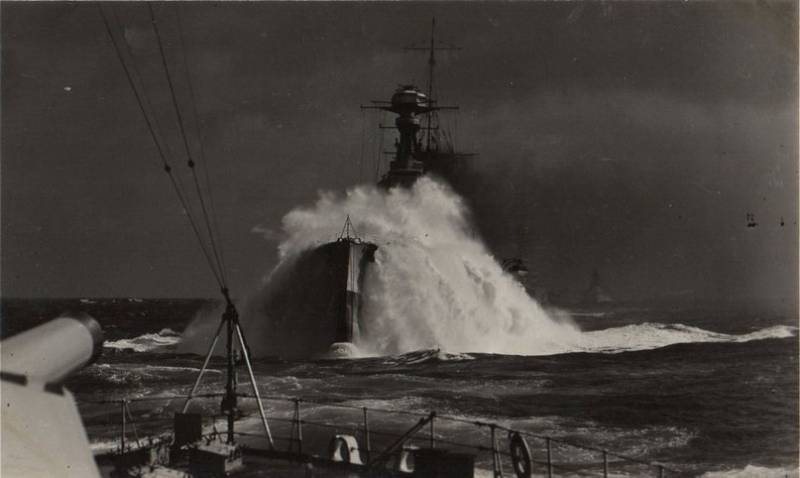
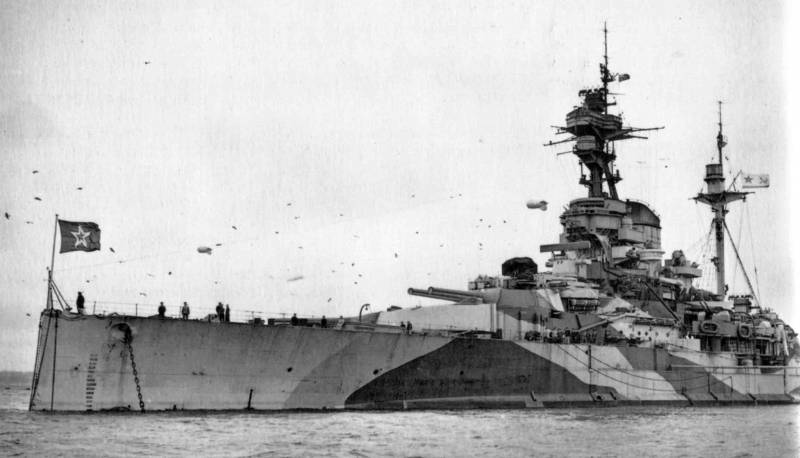
Information